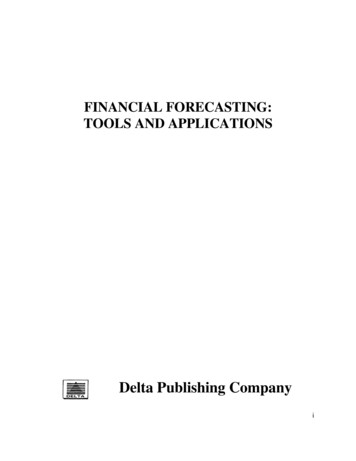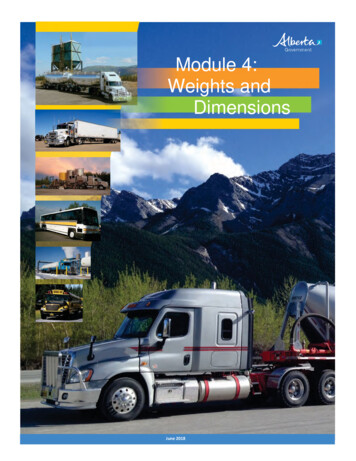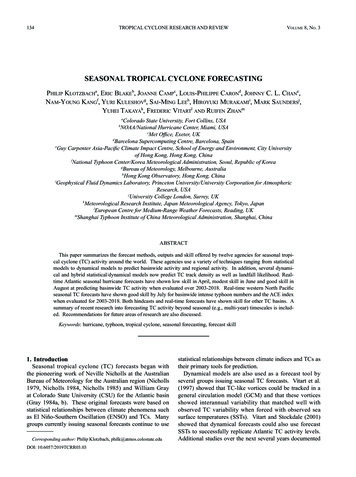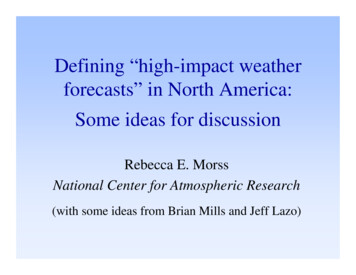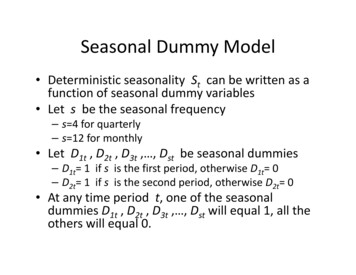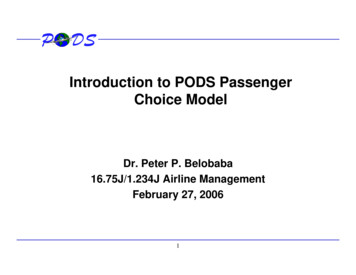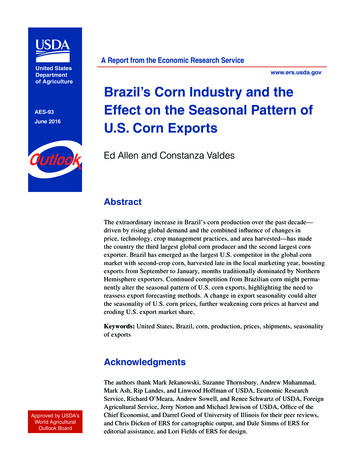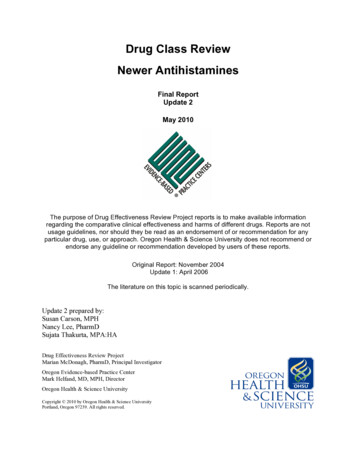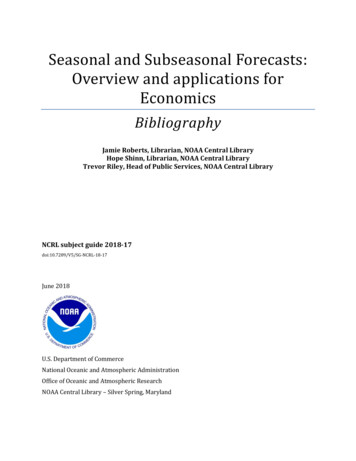
Transcription
Seasonal and Subseasonal Forecasts:Overview and applications forEconomicsBibliographyJamie Roberts, Librarian, NOAA Central LibraryHope Shinn, Librarian, NOAA Central LibraryTrevor Riley, Head of Public Services, NOAA Central LibraryNCRL subject guide 2018-17doi:10.7289/V5/SG-NCRL-18-17June 2018U.S. Department of CommerceNational Oceanic and Atmospheric AdministrationOffice of Oceanic and Atmospheric ResearchNOAA Central Library – Silver Spring, Maryland
ContentsBackground & Scope . 3Sources Reviewed . 3Section I: Overview of Seasonal and Subseasonal Forecasts . 4Section II: Agriculture. 7Section III: Aquaculture and Fisheries. 23Section IV: Water Resource Management. 25Section V: Health and Safety . 282
Background & ScopePer the Weather Research and Forecasting Innovation Act of 2017, NOAA’s NationalWeather Service is required to collect and utilize information to make reliable and timelyfoundational forecasts of subseasonal and seasonal temperature and precipitation. As weathertechnology progresses, it becomes easier to create seasonal and subseasonal forecasts. What arethe potential uses for these forecasts? In what fields would they be of especially high value? Thisbibliography explores research primarily from the last twenty years on these longer term forecastsand their applications, especially their potential and existing economic impacts. It is organized intofive sections: a general overview of seasonal and subseasonal forecasts, their applications foragriculture, their applications for aquaculture and fisheries, their applications for water resourcemanagement, and their applications for health and safety.Section I – Overview of Seasonal and Subseasonal ForecastsSection one is intended to provide an overview of the current and potential value of seasonal andsubseasonal forecasts. It covers value assessments and projections for future use and research.Section II – Applications for AgricultureSection two is intended to provide an overview of research applying seasonal and subseasonalforecasts to agricultural issues. It covers potential benefits, models for integrating seasonalforecasting into current agricultural practice, economic valuations, and assessments of their currentor future use by farmers around the world.Section III – Applications for Aquaculture and FisheriesSection two is intended to provide an overview of research applying seasonal and subseasonalforecasts to aquaculture and fisheries management. It covers sustainability, risk management, andfishery management.Section IV – Applications for Water Resource ManagementSection two is intended to provide an overview of research applying seasonal and subseasonalforecasts to water resource management. It covers forecast models, decision making frameworks,and valuations of long term forecasts for water management.Section V – Applications for Health and SafetySection two is intended to provide an overview of research applying seasonal and subseasonalforecasts to health and safety issues. It covers forecast guidance, risk management, and warningsystems as they relate to human health especially in terms of heat waves.Sources ReviewedAlong with a web search for relevant materials the following databases were used to identifysources: Clarivate’s Web of Science: Science Citation Index Expanded, Elsevier’s Science Direct,ProQuest’s Science and Technology including ASFA and MGA, EconLit Full-Text, and Lexis Advance.Only English language materials were included and there was no date range specification.3
Section I: Overview of Seasonal and Subseasonal ForecastsAlessandri, A., De Felice, M., Catalano, F., Lee, J. Y., Wang, B., Lee, D. Y., et al. (2018). Grand Europeanand Asian-Pacific multi-model seasonal forecasts: maximization of skill and of potentialeconomical value to end-users. Climate Dynamics, 50(7-8), yMulti-model ensembles (MMEs) are powerful tools in dynamical climate prediction as they accountfor the overconfidence and the uncertainties related to single-model ensembles. Previous workssuggested that the potential benefit that can be expected by using a MME amplifies with theincrease of the independence of the contributing Seasonal Prediction Systems. In this work wecombine the two MME Seasonal Prediction Systems (SPSs) independently developed by theEuropean (ENSEMBLES) and by the Asian-Pacific (APCC/CliPAS) communities. To this aim, all thepossible multi-model combinations obtained by putting together the 5 models from ENSEMBLESand the 11 models from APCC/CliPAS have been evaluated. The results demonstrate the usefulapplication of MME seasonal predictions for energy demand forecasting over Italy. It is shown asignificant enhancement of the potential economic value of forecasting energy demand when usingthe better combinations from the Grand MME by comparison to the maximum value obtained fromthe better combinations of each of the two contributing MMEs. The above results demonstrate forthe first time the potential of the Grand MME to significantly contribute in obtaining usefulpredictions at the seasonal time-scale.Marta, B. S., Meaghan, D., & Suraje, D. (2018). Assessing the value of seasonal climate forecasts fordecision‐making. Wiley Interdisciplinary Reviews: Climate Change, 9(4), e523.https://doi.org/10.1002/wcc.523Seasonal climate forecasts (SCF) can support decision‐making and thus help society cope with andprepare for climate variability and change. The demand for understanding the value and benefits ofusing SCF in decision‐making processes can be associated with different logics. Two of these wouldbe the need to justify public and private investment in the provision of SCF and demonstrating thegains and benefits of using SCF in specific decision‐making contexts. This paper reviews the mainfactors influencing how SCF is (or can be) valued in supporting decision‐making and the mainmethods and metrics currently used to perform such valuations. Our review results in four keyfindings: (a) there is a current emphasis on economic ex ante studies and the quantification of SCFvalue; (b) there are fundamental differences in how the value of SCF is defined and estimatedacross methods and approaches; (c) most valuation methods are unable to capture the differentialbenefits and risks of using SCF across spatiotemporal scales and groups; and (d) there is limitedinvolvement of the decision‐makers in the valuation process. The paper concludes by providingsome guiding principles towards more effective valuations of SCF, notably the need for a widerdiversity and integration of methodological approaches. These should particularly embrace ex‐post,qualitative, and participatory approaches which allow co‐evaluation with decision‐makers so thatmore comprehensive and equitable SCF valuations can be developed in future.White, C.J. et al. (2017). Potential applications of subseasonal‐to‐seasonal (S2S) predictions.Meteorological Applications. https://doi.org/10.1002/met.1654While seasonal outlooks have been operational for many years, until recently the extended‐rangetimescale referred to as subseasonal‐to‐seasonal (S2S) has received little attention. S2S prediction4
fills the gap between short‐range weather prediction and long‐range seasonal outlooks. Decisionsin a range of sectors are made in this extended‐range lead time; therefore, there is a strong demandfor this new generation of forecasts. International efforts are under way to identify key sources ofpredictability, improve forecast skill and operationalize aspects of S2S forecasts; however,challenges remain in advancing this new frontier. If S2S predictions are to be used effectively, it isimportant that, along with science advances, an effort is made to develop, communicate and applythese forecasts appropriately. In this study, the emerging operational S2S forecasts are presented tothe wider weather and climate applications community by undertaking the first comprehensivereview of sectoral applications of S2S predictions, including public health, disaster preparedness,water management, energy and agriculture. The value of applications‐relevant S2S predictions isexplored, and the opportunities and challenges facing their uptake are highlighted. It is shown howsocial sciences can be integrated with S2S development, from communication to decision‐makingand valuation of forecasts, to enhance the benefits of ‘climate services’ approaches for extended‐range forecasting. While S2S forecasting is at a relatively early stage of development, it is concludedthat it presents a significant new window of opportunity that can be explored for application‐readycapabilities that could allow many sectors the opportunity to systematically plan on a new timehorizon.Crean, J., Parton, K., Mullen, J., & Hayman, P. (2015). Valuing Seasonal Climate Forecasts in a StateContingent Manner. Australian Journal of Agricultural and Resource Economics, 59(1), 6177. 8ISSN%291467-8489/issuesWe applied state-contingent theory to climate uncertainty at a farm level to assess the value ofseasonal climate forecasts in the Central West region of NSW. We find that modelling uncertainty ina state-contingent manner results in a lower estimate of forecast value than the typical expectedvalue approach. We attribute this finding to a more conservative long-term farm plan in thediscrete stochastic programming (DSP) model, which is better balanced for climate uncertainty.Hence, a climate forecast, even though it still revises probabilities held by farmers, does not callforth such large changes in farm plans and associated farm incomes. We then use the DSP model toassess how attributes of a hypothetical forecasting system, particularly its skill and timeliness, aswell as attributes of the decision environment, influence its value. Lastly, we assess the value ofcurrent operational forecast systems and show that the value derived from seasonal climateforecasts is relatively limited in the case study region largely because of low skill embodied inforecasts at the time when major farm decisions are being made.Robertson, A. W., Kumar, A., Peña, M., & Vitart, F. (2014). Improving and Promoting Subseasonal toSeasonal Prediction. Bulletin of the American Meteorological Society, 96(3), 1There is growing interest in the scientific, operational, and applications communities in developingforecasts that fill the gap between medium-range weather forecasts (up to 2 weeks) and long-rangeor seasonal ones (3–6 months). A new World Weather Research Programme/World ClimateResearch Programme (WWRP/WCRP initiative on subseasonal to seasonal (S2S) prediction hasrecently been launched to foster collaboration and research in the weather and climatecommunities, with the goals of improving forecast skill and physical understanding, promotingforecast uptake by operational centers, and exploitation by the applications community. A keycomponent of the project is to create an archive of S2S operational forecasts from EPSs (see Table 1for project and model acronyms) that will become available in 2015. The meeting was the firstscientific conference organized by the World Meteorological Organization (WMO)’s S2S steering5
group and U.S. THORPEX members, and it aimed to bring together the research and applicationscommunities with operational centers interested in S2S prediction.Doblas-Reyes, F. J., Garcia-Serrano, J., Lienert, F., Biescas, A. P., & Rodrigues, L. R. L. (2013). Seasonalclimate predictability and forecasting: status and prospects. Wiley InterdisciplinaryReviews-Climate Change, 4(4), 245-268. https://doi.org/10.1002/wcc.217Seasonal climate forecasts occupy an intermediate zone between weather forecasting and climateprojections. They share with the numerical weather prediction the difficulty of initializing thesimulations with a realistic state of the atmosphere and the need to periodically verify differentaspects of their quality, while additionally are burdened by uncertainties in feedback processes thatalso play a central role in constraining climate projections. Seasonal predictions have to deal alsowith the challenge of initializing all the components of the climate system (ocean, sea ice, and landsurface). The value of skilful seasonal forecasts is obvious for many societal sectors and is currentlybeing included in the framework of developing climate services. Seasonal forecasts will in additionbe valuable by increasing the acceptance of climate projections among the general public. Thisadvanced-review article presents an overview of the state-of-the-art in global seasonalpredictability and forecasting for climate researchers and discusses fundamental advances toincrease forecast quality in the near future. The article concludes with a list of challenges whereseasonal forecasting is expected to focus on in the near future.Millner, A., & Washington, R. (2011). What determines perceived value of seasonal climateforecasts? A theoretical analysis. Global Environmental Change, 21(1), 8.001Seasonal forecasts have potential value as tools for the management of risks due to inter-annualclimate variability and iterative adaptation to climate change. Despite their potential, forecasts arenot widely used, in part due to poor performance and lack of relevance to specific users’ decisionproblems, and in part due to a variety of economic and behavioural factors. In this paper atheoretical model of perceived forecast value is proposed and applied to a stylized portfolio-typedecision problem with wide applicability to actual forecast users, with a view to obtaining a morecomplete picture of the determinants of perceived value. The effects of user wealth, risk aversion,and perceived forecast trustworthiness, and presentational parameters, such as the position offorecast parameter categories, and the size of probability categories, on perceived value isinvestigated. Analysis of the model provides several strong qualitative predictions of how perceivedforecast value depends on these factors. These predictions may be used to generate empiricalhypotheses which offer the chance of evaluating the model's assumptions, and suggest severalmeans of improving understanding of perceived value based on qualitative features of the results.Arun, K. (2010). On the assessment of the value of the seasonal forecast information. MeteorologicalApplications, 17(4), 385-392. https://doi.org/10.1002/met.167Seasonal climate forecasts are now routinely produced at many operational and research centres.With the availability of the emerging technology of seasonal climate predictions for managing risks,however, it has proven difficult to quantify the value of seasonal climate forecasts in variousapplications. The definition of the value in the context of the use of the Seasonal ForecastInformation (SFI) is the net benefit a user (or society) incurs as a result of change in management6
practices in response to the availability of the SFI. A review of the difficulties associated with thevalue assessment of the SFI is presented. The paper includes a broad overview of pathways how theSFI is used by the various users and applications. The discussion then summarizes difficultiesassociated with isolating the benefits of the use of the SFI leading to the current paradigm wherethe value assessments from the use of the SFI are hard to quantify.Lemos Maria, C., & Rood Richard, B. (2010). Climate projections and their impact on policy andpractice. Wiley Interdisciplinary Reviews: Climate Change, 1(5), 670-682.https://doi.org/10.1002/wcc.71This article examines the relationship between projections of climate change and the responses tothose projections. First, it discusses uncertainty and its role in shaping not only the production ofclimate projections but also the use of these projections by decision makers. We find thatuncertainty critically affects the way climate projections move from useful to usable, whereusefulness is defined by scientists' perception of users' needs, and usability is defined by users'perception of what knowledge can be readily applied to their decision. From the point of view of thenatural scientist, we pose that there is an uncertainty fallacy, that is, a belief that the systematicreduction of uncertainty in climate projections is required in order for the projections to be used bydecision makers. Second, we explore the implications of climate projections for policy and decisionmaking, using examples from the seasonal climate forecast applications literature as an analog. Weexamine constraints and opportunities for their application in policy and practice and find that overreliance on science and technical solutions might crowd out the moral imperative to do what isneeded to improve livelihoods and to guarantee ecosystems' long term sustainability. We concludethat, in the context of high uncertainty, decision makers should not look for perfect forecasts, butseek to implement knowledge systems that integrate climate projections with other kinds ofknowledge and that consider the multiple stressors that shape their decision environment.Section II: AgricultureCeglar, A., Toreti, A., Prodhomme, C., Zampieri, M., Turco, M., & Doblas-Reyes, F. J. (2018). Landsurface initialisation improves seasonal climate prediction skill for maize yield forecast.Scientific Reports, 8. https://doi.org/10.1038/s41598-018-19586-6Seasonal crop yield forecasting represents an important source of information to maintain marketstability, minimise socio-economic impacts of crop losses and guarantee humanitarian foodassistance, while it fosters the use of climate information favouring adaptation strategies. Asclimate variability and extremes have significant influence on agricultural production, the earlyprediction of severe weather events and unfavourable conditions can contribute to the mitigationof adverse effects. Seasonal climate forecasts provide additional value for agricultural applicationsin several regions of the world. However, they currently play a very limited role in supportingagricultural decisions in Europe, mainly due to the poor skill of relevant surface variables. Here weshow how a combined stress index (CSI), considering both drought and heat stress in summer, canpredict maize yield in Europe and how land-surface initialised seasonal climate forecasts can beused to predict it. The CSI explains on average nearly 53% of the inter-annual maize yieldvariability under observed climate conditions and shows how concurrent heat stress and droughtevents have influenced recent yield anomalies. Seasonal climate forecast initialised with realisticland-surface achieves better (and marginally useful) skill in predicting the CSI than with7
climatological land-surface initialisation in south-eastern Europe, part of central Europe, Franceand Italy.Hardegree, S. P., Abatzoglou, J. T., Brunson, M. W., Germino, M. J., Hegewisch, K. C., Moffet, C. A., . . .Meredith, G. R. (2018). Weather-Centric Rangeland Revegetation Planning. RangelandEcology & Management, 71(1), 1-11. https://doi.org10.1016/j.rama.2017.07.003Invasive annual weeds negatively impact ecosystem services and pose a major conservation threaton semiarid rangelands throughout the western United States. Rehabilitation of these rangelands ischallenging due to interannual climate and subseasonal weather variability that impacts seedgermination, seedling survival and establishment, annual weed dynamics, wildfire frequency, andsoil stability. Rehabilitation and restoration outcomes could be improved by adopting a weathercentric approach that uses the full spectrum of available site-specific weather information fromhistorical observations, seasonal climate forecasts, and climate-change projections. Climate datacan be used retrospectively to interpret success or failure of past seedings by describing seasonaland longer-term patterns of environmental variability subsequent to planting. A more detailedevaluation of weather impacts on site conditions may yield more flexible adaptive-managementstrategies for rangeland restoration and rehabilitation, as well as provide estimates of transitionprobabilities between desirable and undesirable vegetation states. Skillful seasonal climateforecasts could greatly improve the cost efficiency of management treatments by limitingrevegetation activities to time periods where forecasts suggest higher probabilities of successfulseedling establishment.Nidumolu, U., Lim-Camacho, L., Gaillard, E., Hayman, P., & Howden, M. (2018). Linking climateforecasts to rural livelihoods: Mapping decisions, information networks and value chains.Weather and Climate Extremes. https://doi.org/10.1016/j.wace.2018.06.001Climate variability is a key source of livelihood risks faced by smallholder farmers in drierenvironments in many developing countries. Climate information provided on seasonal time-scalescan sometimes improve agricultural decision-making. However, there are many barriers to theeffective dissemination, communication and use of such information on farm and across the valuechain. We used a case study in southern India to explore ways of overcoming some of these barrierssuch as those limiting access to information and effective communication of probabilistic forecastinformation. Firstly, we used social network analysis at the village level to identify particularindividuals, groups or/and institutions who are central in information networks so as to be able tosupport them to increase the efficiency, effectiveness, equity and robustness of informationtransfers. This allowed us to identify potential opportunities and challenges around access,communication and forecast use. Close linking of formal and informal networks appeared to be acommon, positive influencing factor. Secondly, we used value chain analysis to assess how pre-andpost-farm decision-makers could use seasonal climate forecasts (SCF) in their own businesses andhow this may propagate up and down the value chain. We found that the motivation for using SCFvaried across the value chain and was likely of limited use to smaller, off-farm value chain playerswho take a short-term adaptive management approach to planning. However, it was seen as havingsignificant potential for larger businesses who take a more strategic approach. This identified apossible risk of increased competitive inequality between businesses of different sizes. Thirdly, weaddressed the challenge of translating probabilistic climate forecast information into support fordecision making by using decision analysis with intermediaries enabling them to structure clearlyproblems with embedded climate probabilities. The construction of decision-trees enabled farmadvisers and local researchers to explore the potential value of SCF by using the decision trees as a8
“boundary object” around which farmers and other decision makers, agricultural scientists, climatescientists, economists, social scientists and policy-makers could have thoughtful discussion leadingto useful strategies to better manage climate risk.Ogutu, G. E. O., Franssen, W. H. P., Supit, I., Omondi, P., & Hutjes, R. W. A. (2018). Probabilistic maizeyield prediction over East Africa using dynamic ensemble seasonal climate forecasts.Agricultural and Forest Meteorology, 250, 2.256We tested the usefulness of seasonal climate predictions for impacts prediction in eastern Africa. Inregions where these seasonal predictions showed skill we tested if the skill also translated intomaize yield forecasting skills. Using European Centre for Medium-Range Weather Forecasts(ECMWF) system-4 ensemble seasonal climate hindcasts for the period 1981-2010 at differentinitialization dates before sowing, we generated a 15 member ensemble of yield predictions usingthe World Food Studies (WOFOST) crop model implemented for water-limited maize productionand single season simulation. Maize yield predictions are validated against reference yieldsimulations using the WATCH Forcing Data ERA-Interim (WFDEI), focusing on the dominantsowing dates in the northern region (July), equatorial region (March-April) and in the southernregion (December). These reference yields show good anomaly correlations compared to theofficial FAO and national reported statistics, but the average reference yield values are lower thanthose reported in Kenya and Ethiopia, but slightly higher in Tanzania. We use the ensemble mean,interannual variability, mean errors, Ranked Probability Skill Score (RPSS) and Relative OperatingCurve skill Score (ROCSS) to assess regions of useful probabilistic prediction. Annual yieldanomalies are predictable 2-months before sowing in most of the regions. Difference in interannualvariability between the reference and predicted yields range from /- 40%, but higher interannualvariability in predicted yield dominates. Anomaly correlations between the reference and predictedyields are largely positive and range from 0.3 to 0.6. The ROCSS illustrate good pre-seasonprobabilistic prediction of above-normal and below normal yields with at least 2-months lead time.From the sample sowing dates considered, we concluded that, there is potential to use dynamicalseasonal climate forecasts with a process based crop simulation model WOFOST to predictanomalous water-limited maize yields.Ouédraogo, M., Barry, S., Zougmoré, R., Partey, S., Somé, L., & Baki, G. (2018). Farmers’ Willingnessto Pay for Climate Information Services: Evidence from Cowpea and Sesame Producers inNorthern Burkina Faso. Sustainability, 10(3), 611. https://doi.org/10.3390/su10030611Climate information is recognized as a powerful tool to reduce the effect of climate risk anduncertainty on crop production and increase the resilience and the adaptive capacity of farmers insemi-arid zones. This paper estimates farmers’ willingness to pay (WTP) for climate informationwithin cowpea and sesame value chains in Northern Burkina Faso. The study used the contingentvaluation method for a monetary valuation of farmers’ preferences for climate information. Datawere collected using a structured questionnaire from 170 farmers. The study found that63% of respondents were willing to pay for climate information services (CIS) such as seasonalclimate forecast (SCF), decadal climate information (10-DCI), daily climate information (1-DCI) andagro-advisories. The predicted value for the WTP was XOF 3496 for SCF, XOF 1066 for 10-DCI, XOF1985 for 1-DCI and XOF 1628 for agro-advisories. The study also showed that severalsocioeconomic and motivation factors have greater influence on farmers’ WTP for CIS. Theseincluded the gender, age, education of the farm head and the awareness of farm head to climate9
information. The outcomes of this paper should support policy makers to better design an efficientmechanism for the dissemination of climate information to improve the adaptive capacity offarmers to climate risks in Burkina Faso.Rodriguez, D., de Voil, P., Hudson, D., Brown, J. N., Hayman, P., Marrou, H., & Meinke, H. (2018).Predicting optimum crop designs using crop models and seasonal climate forecasts.Scientific Reports, 8(1), 2231. https://doi.org/10.1038/s41598-018-20628-2Expected increases in food demand and the need to limit the incorporation of new lands intoagriculture to curtail emissions, highlight the urgency to bridge productivity gaps, increase farmersprofits and manage risks in dryland cropping. A way to bridge those gaps is to identify optimumcombination of genetics (G), and agronomic managements (M) i.e. crop designs (GxM), for theprevailing and expected growing environment (E). Our understanding of crop stress physiologyindicates that in hindsight, those optimum crop designs should be known, while the main problemis to predict relevant attributes of the E, at the time of sowing, so that optimum GxM combinationscould be informed. Here we test our capacity to inform that “hindsight”, by linking a tested cropmodel (APSIM) with a skillful seasonal climate forecasting system, to answer “What is the value ofthe skill in seasonal climate forecasting, to inform crop designs?” Results showed that the GCMPOAMA-2 was reliable and skillful, and that when linked with APSIM, optimum crop designs couldbe informed. We conclude that reliable and skillful GCMs that are easily interfaced with cropsimulation models can be used to inform optimum crop designs, increase farmers profits andreduce risks.Templeton, S. R., Hooper, A. A., Aldridge, H. D., & Breuer, N. (2018). Farmer Interest in and Uses ofClimate Forecasts for Florida and the Carolinas: Conditional Perspectives of ExtensionPersonnel. Weather, Climate, and Society, 10(1), 103-120. https://doi.org/10.1175/wcas-d16-0057.1In baseline surveys that were conducted in Florida, North Carolina, and South Carolina, extensionpersonnel were asked whether, how, and which farmers would use climate forecasts to manageproduction and other aspects of their agribusinesses. In making such assessments extens
Section two is intended to provide an overview of research applying seasonal and subseasonal forecasts to agricultural issues. It covers potential benefits, models for integrating seasonal forecasting into current agricultural practice, economic valuations, and assessments of their current or future use by farmers around the world.Author: Jamie Roberts, Hope Shinn, Trevor RileyPublish Year: 2018
